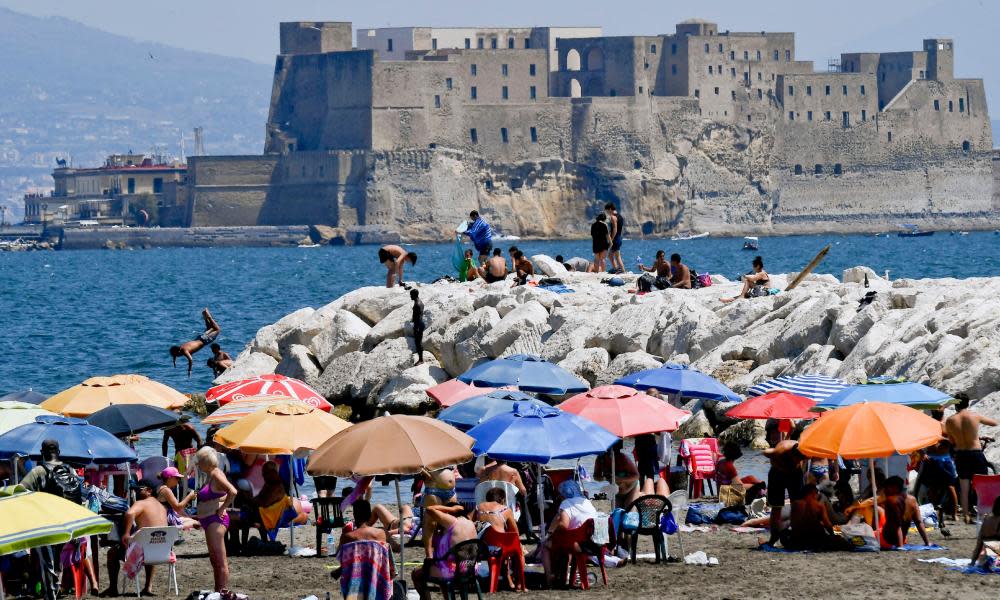Italy at a crossroads as fears grow of Covid-19 second wave

It took a weekend to take Italy back three months in its struggle against the pandemic. Last week’s rapid increase in coronavirus infections risks erasing the progress made by the first European country to be engulfed by Covid-19 and extending the closure of schools in September.
The alarm was sounded last Saturday, when Italy registered 629 new cases in 24 hours, up from 500 on the previous two days. Such numbers recorded in a row had not been seen since May, when Italy cautiously emerged from one of the longest lockdowns in the world after more than 30,000 Covid-related deaths.
On Sunday the government ordered the closure of discotheques and made masks compulsory outdoors in specific areas at night – the first real restrictions since the lockdown eased.
“We cannot nullify the sacrifices made in past months,” said the health minister, Roberto Speranza, as the spectre of a second wave began to spread across the country.
Walter Ricciardi, a senior adviser to the Italian health ministry on the coronavirus outbreak, told the Guardian: “Italy is at a crossroads right now. If we do not apply containment measures and the numbers continue to rise, localised lockdowns will be required.”
Italy’s first wave of the pandemic was brutal, with more than 250,000 infections, peaking at about 6,000 cases a day in March. “We wouldn’t have the physical or psychological force to face a new one,” said Ettore Consonni, 61, a retired warehouse worker from Bergamo who tested positive in March and was in a coma for 27 days.
At the time in Lombardy there were no beds available in the hospitals, so Consonni was transferred to Sicily. “I fell asleep in Bergamo, my city in the extreme north, and woke up in the deep south, in Palermo. And as my body lay in a bed connected to an artificial respirator, in Bergamo over 100 people died, including my brother. It enrages me to think that those deaths and our pain risk could be in vain. No, we cannot allow ourselves to go back.”
In the last months, contact tracing and compliance with safety measures had helped Italy to achieve a stable, low rate of new Covid-19 infections. Then, suddenly, something went wrong.
The majority of people who have tested positive in recent days are young holidaymakers returning from Greece, Spain, Malta and Croatia. For this reason, last Friday the government obliged arrivals from these four countries to be tested for the virus. Rome said it was also considering adding France to the list.
On Tuesday on the island of Santo Stefano, in the Maddalena archipelago of northern Sardinia, 470 holidaymakers were placed under quarantine after a 60-year-old resort employee tested positive.
“It is proper to monitor people who arrive from those countries where coronavirus cases are on the rise,” said Massimo Galli, the director of infectious diseases at the Sacco hospital in Milan. “I wonder, however, why this same attention is not being carried out on people who have never left the country. I understand the need to go back to normalcy. What I don’t understand are the contradictions in some choices that could have been avoided. I read, for example, that the government has decided to close discotheques. I ask myself why they even reopened them in the first place.”
Watch video below
In May, in a speech announcing the easing of restrictions, the prime minister, Giuseppe Conte, spoke of a “calculated risk”. “We are aware that at some point the epidemiological curve could continue to rise,” he said. “But we accept the risk, otherwise we will never be able to start again.”
The number of new infections in recent days seems to be the price Italy is paying in order to put the economy back on track, especially in the tourism sector.
As the country began to emerge from lockdown, authorities were obliged to strike a balance between the need to reopen public spaces and national borders, fundamental for economic recovery, and the obligation to safeguard public health. What if Rome went too far?
“I am amazed how Italy has gone from one of the strictest lockdowns in Europe to tana libera tutti [free for all],” said Marta Esperti, a 32-year-old PhD candidate who tested positive in March and still has a fever and other symptoms of Covid-19. “I am very worried, because people in Italy seem to have forgotten about the existence of the virus or what it has caused.”
Related: 'A generation has died': Italian province struggles to bury its coronavirus dead
On the crowded beaches of southern Italy, the peak of the crisis seems like a distant bad memory. “Today we are dealing with a virus that may appear to be weakened, given the high temperatures that mitigate its spread,” said Tullio Prestileo, a doctor of infectious diseases at the Benfratelli hospital in Palermo, referring to a theory about the virus’s spread in summer.
“But what will happen when temperatures begin to fall? And above all, what sense is there in closing discotheques if in less than a month schools will reopen and 20 or 30 students will be in a classroom together?”
Schools were ordered to close in late February and have not opened since. Their reopening in September is the government’s top priority.
“We must reopen schools and we can make no mistakes,” said Speranza, the health minister, in an interview with La Repubblica. “The end of this saga is not over. It depends on our behaviour, and we must all be vigilant.”

 Yahoo News
Yahoo News 
